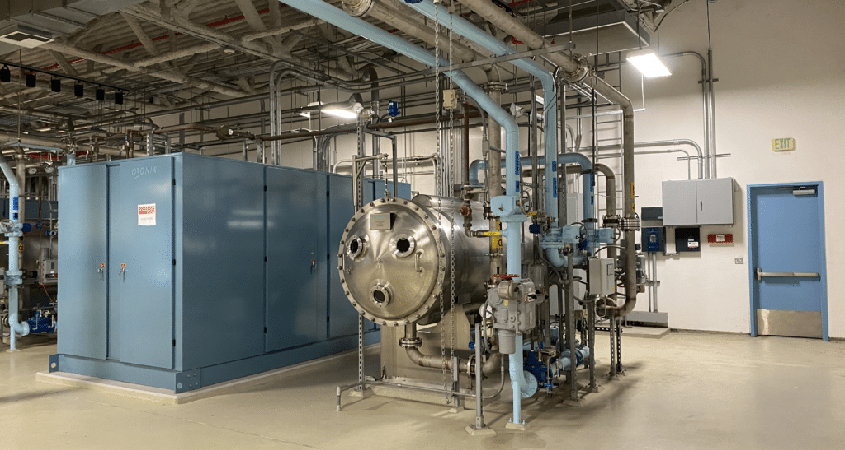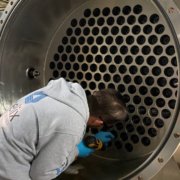You are now in California and the U.S. Home Headline Media Coverage category.
Helix Water District Reduces Plant Upgrade Costs
When the Helix Water District received contractor estimates as high as $3.5 million to upgrade the R.M. Levy Water Treatment Plant’s ozone power supply units and generators, it decided to perform the upgrade in-house.
With Suez Water Technologies provided engineering and equipment, Helix employees incorporated new technology and innovative installation practices. The proof of concept pilot project proved the feasibility of the new approach, and a full retrofit is now planned. The estimated upgrade costs to complete the full project is $1.1 million – an approximately 70% cost savings. The upgrade will extend the life of the power supply units and generators at least 15 years.
Reducing upgrade costs saves ratepayers
“The ozone project is our latest example of cost-effective local government,” said Brian Olney, Helix Water District director of water quality and system operations. “In early 2020, Helix staff also standardized the design, hardware, and software of the motor control centers in the district’s 25 pump stations, and that project also saved our customers money, and created long-term operating, maintenance and purchasing efficiencies.”
Ozone treatment provides safe and reliable water to East County

The ozone generator at Helix Water District’s R.M. Levy Water Treatment Plant in Lakeside. Photo: Helix Water District
The water treatment process at the R.M. Levy Water Treatment plant begins with the removal of dirt and other material suspended in the water. Ozone is then used to inactivate or destroy any organisms in the water. Ozone offers important advantages over chlorine:
- Ozone destroys or inactivates a wide range of organisms in the water
- Ozone needs little contact time with the water to be effective
- Ozone produces fewer potentially harmful disinfection byproducts than other disinfectants
- Ozone removes most of the smell and taste issues people associate with tap water

Helix Water District’s ozone project team (pre-pandemic) in front of the rebuilt power supply unit. Photo: Helix Water District
Ozone is naturally unstable at normal atmospheric conditions, which is why Helix needs ozone generators to produce it on site. The high voltage generators break down oxygen molecules (O2) and form ozone (O3). The ozone molecules are then diffused in a contact chamber and bubble up through the water to destroy any organisms present.
After ozonation, Helix Water District filters the water and adds a dose of chloramines — chlorine and ammonia — to maintain water quality throughout its 737 miles of water distribution pipelines. The treatment process is managed by a team of highly trained plant operators who conduct 200 water quality tests per day. Chemists and biologists test water samples from both the plant and the distribution system as well.
Sweetwater Authority Begins Transfer Between Reservoirs to Generate Savings
Sweetwater Authority began a controlled transfer of water between its two reservoirs Monday to bolster a low water level in one of them. Water that leaves Loveland Reservoir south of Alpine will be transferred over the next several weeks through the Sweetwater River channel and captured at Sweetwater Reservoir where it can be treated and distributed to authority customers at a lower cost than importing water. Loveland Reservoir is more than 70% full, while Sweetwater Reservoir’s level is at 20% of capacity.
Controlled Transfer of Water from Sweetwater Authority’s Loveland Reservoir Begins Today
Chula Vista, Calif. – In order to secure additional water sources for our customers, Sweetwater Authority initiated a controlled transfer of water from its two reservoirs on Monday, January 11, 2021.
ETGSA Approves $22,000 Contribution to WBSJV
On Thursday afternoon, the Eastern Tule Groundwater Sustainability Agency’s Authority Board of Directors hosted a meeting over Zoom, and as part of the agenda the ETGSA approved a contribution to Water Blueprint for the San Joaquin Valley to identify water supplies in the amount of $22,000.
WBSJV has been working to identify the water supplies that might be available to achieve water sustainability in the San Joaquin Valley, including the Tule Subbasin. The ETGSA represents irrigation districts and farmers in southern Tulare County and is part of the Tule Subbasin.
Researchers Exploring How San Diego County Wetlands Can Be Part of Climate-Saving Strategies
Buried in San Diego County’s lagoons are centuries worth of carbon, cached in muddy stockpiles that scientists say could help combat climate change. Recently, scientists with the conservation organization Wildcoast and Scripps Institution of Oceanography started studying how much carbon coastal wetlands can capture, and how to restore these environments to boost that capacity.
Dry Weather Pattern Comes On Heels of One of the Driest, Warmest Falls On Record
December through February is historically when some of the biggest weather systems arrive in Northern California with big rain and snow totals. While March can also be a big snow month, the window of opportunity for big rain and snow totals starts to narrow.
Now, long range outlooks are calling for a week and half long stretch of unseasonably dry and warm weather.
Here’s How Newsom’s Proposing to Spend $4.1 Billion on the Climate and Environment
The $227 billion budget proposed on Friday by Gov. Gavin Newsom includes $4.1 billion in spending on a suite of environmental initiatives meant to fight climate change, gird California against devastating wildfires, reduce smog, and bolster the adoption of clean vehicles on the state’s roads.
Who Owns the Tijuana River – and Who Needs Its Water Most
On a stormy day, 1 billion gallons of water can rage down the river crossing from Tijuana to San Diego.
None of that water is captured for reuse now among the two desert cities it splits, which are regularly prone to drought, because it’s considered polluted by sewage spills on the Mexican side. If successfully recycled, that water could prove to be valuable as the Southwest grows more water-uncertain due to climate change.
Del Mar Horsepark Advocates Release Water Test Results
Advocates working to keep the Del Mar Horsepark open for equestrian shows, a riding school and other activities released a report Friday that indicates the park’s water issues originate outside the property.
Testing lab ALS Group USA Corp. of Irvine examined water samples taken during seasonal rains Dec. 28 upstream and downstream from the horse park. The upstream samples showed significantly higher amounts of coliforms, pollutants that come from human and animal waste.


 Sweetwater Authority Logo 2019
Sweetwater Authority Logo 2019
